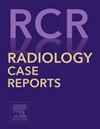Discrepancy between MRI and intraoperative findings in a rare intramedullary epidermoid cyst: A case report and literature review
Q4 Medicine
引用次数: 0
Abstract
Intramedullary epidermoid cysts are rare, benign spinal tumors originating from ectodermal tissue during embryogenesis, comprising less than 1% of intraspinal lesions and posing diagnostic challenges due to their variable presentation and imaging overlap with other spinal pathologies. This case report describes a 22-year-old female who presented with progressive bilateral lower limb weakness, mid-back pain, and bowel-bladder incontinence, with preoperative MRI revealing a well-circumscribed intradural cystic lesion at the T5-T6 level exhibiting mixed-intensity patterns and a “shouldering effect,” initially suggesting an extramedullary location. Surgical exploration, however, confirmed an intramedullary position, and the lesion—characterized intraoperatively as a white, waxy, flaky mass—was excised en-bloc, with histopathology verifying an epidermoid cyst; the patient showed significant neurological recovery by her 12-month follow-up with no recurrence. This case highlights a critical discrepancy between MRI and intraoperative findings, emphasizing the need to integrate clinical, radiological, and surgical observations for accurate diagnosis and management of such rare spinal lesions. It underscores that intramedullary epidermoid cysts, though uncommon, should remain in the differential diagnosis for young adults with progressive neurological deficits, particularly in the thoracic spine, and that complete surgical resection is essential to prevent recurrence. Early diagnosis, meticulous surgical planning, and long-term follow-up are vital for optimizing outcomes, illustrating the importance of adaptability when imaging misaligns with operative reality and reinforcing the value of detailed case reporting to advance understanding of this rare pathology.
罕见髓内表皮样囊肿MRI与术中表现的差异:1例报告并文献复习
髓内表皮样囊肿是一种罕见的良性脊髓肿瘤,起源于胚胎发生期间的外胚层组织,占椎管内病变的不到1%,由于其不同的表现和与其他脊柱病理的成像重叠,给诊断带来了挑战。本病例报告描述了一名22岁的女性,她表现为进行性双侧下肢无力、中背部疼痛和肠膀胱失禁,术前MRI显示在T5-T6水平有一个界限清楚的硬膜内囊性病变,表现为混合强度模式和“肩部效应”,最初提示位于髓外。然而,手术探查证实为髓内位置,术中表现为白色蜡状片状肿块的病变被整体切除,组织病理学证实为表皮样囊肿;随访12个月,患者神经功能恢复明显,无复发。本病例强调了MRI和术中发现之间的关键差异,强调需要将临床,放射学和手术观察结合起来,以准确诊断和治疗这种罕见的脊柱病变。它强调髓内表皮样囊肿虽然不常见,但仍应作为进行性神经功能缺损的年轻成人的鉴别诊断,特别是胸椎,并且完全手术切除是防止复发的必要条件。早期诊断,细致的手术计划和长期随访对于优化结果至关重要,说明了当图像与手术现实不一致时适应性的重要性,并加强了详细病例报告的价值,以促进对这种罕见病理的理解。
本文章由计算机程序翻译,如有差异,请以英文原文为准。
求助全文
约1分钟内获得全文
求助全文
来源期刊

Radiology Case Reports
Medicine-Radiology, Nuclear Medicine and Imaging
CiteScore
1.10
自引率
0.00%
发文量
1074
审稿时长
30 days
期刊介绍:
The content of this journal is exclusively case reports that feature diagnostic imaging. Categories in which case reports can be placed include the musculoskeletal system, spine, central nervous system, head and neck, cardiovascular, chest, gastrointestinal, genitourinary, multisystem, pediatric, emergency, women''s imaging, oncologic, normal variants, medical devices, foreign bodies, interventional radiology, nuclear medicine, molecular imaging, ultrasonography, imaging artifacts, forensic, anthropological, and medical-legal. Articles must be well-documented and include a review of the appropriate literature.
 求助内容:
求助内容: 应助结果提醒方式:
应助结果提醒方式:


